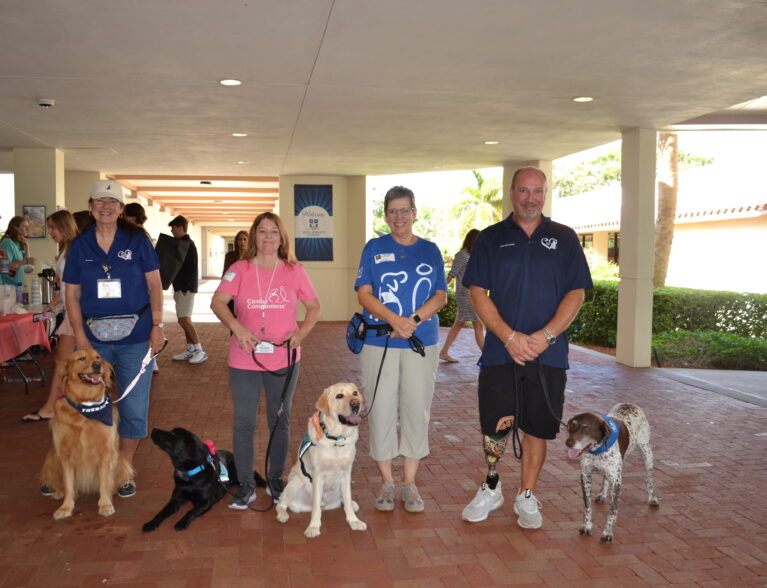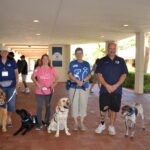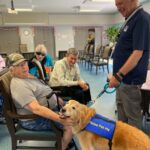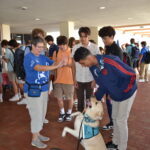
Turns out there’s an almost magical healing power in the touch of a warm nose or sloppy kiss from a loving dog. So much so that Vero Beach hospitals, nursing homes and special care facilities are inviting therapy dog teams to their facilities to boost mental wellbeing, improve physical health and provide emotional support for both patients and caregivers.
Multiple studies have shown that interaction with animals can reduce stress, anxiety and depression. Just petting a dog can increase the production of serotonin and dopamine, neurotransmitters that play a crucial role in mood regulation and the feeling of happiness.
Additionally, the presence of a dog or other therapy animal can lower cortisol, the hormone associated with stress.
For the Love of Paws sends dog therapy teams to 15 facilities in Indian River County that have asked for the service, including Cleveland Clinic Indian River Hospital, VNA, Scully Welsh Cancer Center, Senior Resource Association, numerous assisted care facilities and nursing homes, along with schools and libraries. Requests for visits far exceed the capacity of existing teams, so the organization is actively looking for more dog therapy teams to join its program.
“Our mission is to bring smiles, comfort and joy by visiting with certified therapy dog teams,” said Larry Solomon, therapy dog team coordinator at Paws. “We currently have 11 nationally certified and insured therapy dogs that are itching to make someone’s day a bit brighter.
“They range in size from 8 pounds to 110 pounds,” Solomon continued. “It’s all about the dog’s temperament, not the breed. When we visit a facility with a therapy dog, we are greeted with smiles everywhere we go, and rooms light up when we enter. I’ve seen patients cry as they pet the dog and others who were stoic come alive as they remember a cherished dog of their own.”
While the most profound benefit of pet therapy is its positive impact on mental health, there are physical benefits as well. Just petting a dog can lead to lower blood pressure, reduced heart rate and improved cardiovascular health. A study in the American Journal of Critical Care reported that heart failure patients who received pet therapy had lower blood pressure and a lower release of harmful neurohormones.
Therapy dogs have been known to aid in the rehabilitation process as well. Patients recovering from surgeries and strokes often show improved motor skills and faster recovery times when involved in animal-assisted therapy. The motivation to move and interact with the dog can be a powerful incentive for patients who might otherwise be reluctant to engage in physical activity.
These gentle therapy dogs seem to absorb whatever pain and anxiety the person in front of them is feeling and effectively reduce their pain. A study published in Pain Medicine found that patients undergoing joint replacement surgery who interacted with a therapy dog reported less pain and used less pain medication compared to those who did not receive pet therapy.
“It’s kind of miraculous when you see the dog/patient relationship unfolding in front of you,” Solomon said. “When I take my therapy dog Howie to a nursing home for example, he seems to seek out the person who needs his love the most and will focus his attention on them first.
“You can almost feel their comfort as they pet his head, or he leans up against them in a loving way. I think it benefits us as handlers just as much as the patient. There is just so much joy in seeing them light up, smile and engage with the dog and each other. Long-term care can be lonely and isolating and a therapy dog seems to be the natural antidote for depression.”
Therapy dogs are gifted communicators who act as social catalysts, encouraging interaction and communication among patients who are otherwise withdrawn. This effect was validated in research published in Anthrozoos that reported increased social interaction among elderly residents in long-term care facilities during pet therapy sessions.
And therapy dogs are not only for those who need care – they also uplift those giving care.
Sandra Block takes her therapy dog Vista to visit hospital staff members and emergency personnel for a much-needed stress break. “These caregivers are under tremendous stress and when Vista comes into the room they’ll kneel down and hug him. For a few minutes they can just soak in his love, and then when they go back to taking care of emergencies they are better equipped emotionally to deal with whatever comes their way.”
Therapy teams are helpful to students, too, and were brought into Saint Edward’s School for stress breaks during exam week. Seniors Grace Gattuso and Daniela Sonzini, presidents of the Active Minds Club, came up with the idea of Caffeine and Canines, where students could meet on the patio, grab a cup of coffee, and hug a therapy dog on their break from exams.
“Grace and I wanted to do something to help everyone de-stress during finals week,” said Sonzini. “What better way to calm down than to hug a dog.”
Four therapy dogs and handlers were on hand to help calm the nerves of the students through a collaborative effort between For the Love of Paws and Canine Companions for Independence, another therapy dog program.
“This is the third-year therapy dogs have been brought in during exam week,” said Block, who has been a team handler for 19 years with Canine Companions.
“We also collaborated with Paws earlier this year for Camp Bright Star, a camp for bereaved children,” Block added. “We all have the same goal of spreading joy and happiness like only a dog can do.”
For the Love of Paws wants to add therapy dog teams to its program. All dogs must be Alliance of Therapy Dogs (ATD) registered and pass extensive testing to make sure they have good manners and do not mind being touched by strangers.
They must be up to date on all inoculations and vaccines and show proof of a negative fecal exam every 12 months. Once the dog and handler pass the handling/good manners part of the test, they are required to complete three successful visits to a medical facility, school or other venue where they interact with strangers in a therapy-like setting.
Two of the visits must be to a medically related facility. During these visits, a tester can evaluate, assist and assess how well the team works together. Once they are approved, they can start spreading the healing and happiness that therapy dogs bring.
For those interested in participating in the program, For the Love of Paws will assist you and your dog in getting the required certification. You can call 772-539-2417 for more information.
Photos by Joshua Kodis









